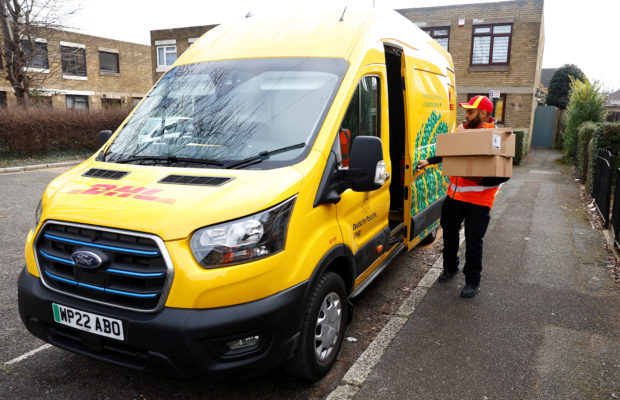Ford taps masses of vehicle data to stay ahead in commercial van market

Senior courier for DHL, Christopher Brownbill, delivers packages from a Ford E-Transit in London, Britain, Feb 9, 2023. REUTERS/Peter Nicholls
DUNTON, England – Ford Motor Co’s push to use reams of data generated by its vans and trucks – from engines to oil filters or brake pads – to attract more customers in the European and U.S. commercial vehicle market plays out on a 9-metre-long (30 ft) screen at its UK headquarters in Dunton east of London.
During a recent visit by Reuters, that screen showed real-time data from 114,000 vans in Britain so far covered by Ford’s FORDLiive monthly subscription service.
Ford employees were focused on the 98.3 percent of the vans that were in service – and of those, roughly 8 percent in need of repairs fairly soon or urgently – but concentrated even more so on the 1.7 percent vehicles out of action.
The U.S. automaker tracks 4,000 data points via modems it has installed in all commercial vehicles since 2019 – and can warn paying customers of engine problems and basics such as brake pad wear, low oil or diesel additives that are cheap to maintain proactively but expensive to fix if not addressed.
The automaker has connected all of its UK dealers to its system, so it can arrange repairs and have parts ready for vans before they arrive at a dealership.
Ford, which leads the commercial vehicle market in both Europe and the United States, launched the system in 2021. Hans Schep, European head of Ford Pro, the company’s commercial vehicle business, said it is already close to hitting long-term targets of increasing vehicle “up time” by up to 60 percent.
Ford estimates that downtime, when a van is out of action, costs an average of 600 pounds ($724) daily per van.
“This has already been a major game-changer,” Schep said.
After a successful test run in Britain, Ford is also rolling out the FORDLiive service in mainland Europe and the United States. The automaker has focused more on its profitable Ford Pro business in Europe than lower-margin mass-market passenger cars.
Ford recently announced engineering job cuts in Europe, but is still hiring software experts for its data services.
Data is a huge battleground for commercial vehicle makers and competition will only intensify with electric models, which are essentially computers on wheels.
Using data to show where vans are, how they consume fuel, how drivers use or misuse them, whether they can skip an oil change, but above all avoiding downtime is becoming as important as the vehicles themselves.
There is also an ongoing fight pitting insurers, leasing companies and car repair shops against carmakers in the European Union over access to connected car data and the vast potential revenue it could generate.
“We plan to grow our leadership position,” said Ted Cannis, chief executive of Ford Pro. “We are going to have many, many more markets that we were not even previously in.”
Easing the electric journey
Electric vans provide far more data points for Ford and its rivals to work with – including tracking how much range they have left and providing easy, comprehensive charging solutions.
Ford’s Schep said providing that data is crucial for van fleets because according to the automaker’s research, 60% of its corporate customers “are really worried about the journey to electric.”
The UK operations of DHL Express, part of the Deutsche Post DHL Group, has 270 electric Ford E Transit vans with firm orders for 120 more, and is signing up for FORDLiive.
Fleet director Richard Crook said aside from monitoring those vans’ batteries, he wants to tap Ford’s predictive maintenance capabilities.
“We need to get ahead of things and plan maintenance schedules because the vehicle is actually telling you ‘I have a problem,’” Crook said.
Ford rival General Motors Co has also rolled out telematics services including “in-vehicle coaching,” where a voice nicknamed “Karen in the vehicle” coaches drivers against excessive braking, speeding or other bad habits.
Michelle Calloway, director of OnStar Business Solutions at GM, said “Karen” cut fuel use by 30 percent in 30 days in one customer’s fleet.
“Those are impactful savings scaled across a large fleet,” Calloway said.
Starting with 2024 models, GM will provide a range of OnStar data services free for fleet vehicles. Ed Peper, who heads GM’s fleet sales, said once customers try those services, they are likely to pay for more.
Italian truck, van and bus maker Iveco Group NV has around 150,000 connected vehicles using telematics services and has seen a 30-percent increase in uptime, plus a “single-digit percent” drop in warranty costs so far, said chief technology officer Marco Liccardo.
Liccardo estimates subscription services will generate 40 percent to 50 percent of commercial vehicle makers’ profits by 2030 and help franchise dealers survive the shift to electric with fewer parts to service.
“Data will be the oxygen to do that,” Liccardo said.
($1 = 0.8289 pound)
Read Next
Subscribe to INQUIRER PLUS to get access to The Philippine Daily Inquirer & other 70+ titles, share up to 5 gadgets, listen to the news, download as early as 4am & share articles on social media. Call 896 6000.
For all the latest Business News Click Here
For the latest news and updates, follow us on Google News.



